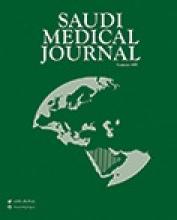REVIEW ARTICLE
A comprehensive review of the prevalence of beta globin gene variations and the co-inheritance of related gene variants in Saudi Arabians with beta-thalassemia
Alaithan et al compile all previously reported beta-hemoglobin gene (HBB) variants from the Saudi population to create a national HBB variation reference source for future research and clinical applications. In Saudi Arabians, IVSI-5 (G>C) and Cd 39 (C>T) are the most prevalent HBB gene variations out of 42 variations. The coinheritance of HBB gene variations with ATRX, HBA1, HBA2, HBA12, AHSP, and KLF1 gene variations were observed to be common in the Saudi population. National surveys on the molecular nature of hemoglobinopathies should be set up through collaborations between research centers from various regions to create a well-documented molecular data bank.
Illustration for the co-inheritance of other gene mutations with HBB gene mutations. The outer grey circle imbedded with a tri-divided colored circle represented 3 HBB gene variations. Each one of the HBB mutation segment overlap exhibits the co-existence of other mutations that floated above them.
see page 329
ORIGINAL ARTICLES
Nurses’ perception and attitudes towards oral care practices for mechanically ventilated patients
Alja’afreh et al conclude that the poor perception and attitudes of ICU nurses regarding oral care for mechanically ventilated (MV) patients require the urgent attention of clinical administrators. In-hospital training regarding oral care protocol could improve nurses’ perception and attitudes. Ninety-six nurses participated in the study. The response rate was 76.8%. The results revealed that 65% only follow a specific oral care protocol. Nurses did not adhere to minimal standards. Although nurses’ attitude towards oral care was strongly positive, 68% of them perceived it as an unpleasant task and 29% agreed that they had insufficient training; 78% agreed to learn more about the best way to perform oral care. Standard descriptive statistics were calculated for all baseline information (sociodemographic characteristics). Binary variables were expressed as proportions, and normally distributed continuous variables as means and standard deviations.
see page 379
Effects of Ramadan fasting on the symptoms of chronic heart failure
Abazid et al investigate the effect of Ramadan fasting on the symptoms of chronic heart failure with a reduced ejection fraction (HFrEF). Data regarding the effect of fasting in heart failure patients with a reduced ejection fraction are limited. Patients from the unstable versus the stable group showed significantly less adherence to medications (67% versus 94%, p<0.0001) and to diet (39% versus 79%, p<0.0001), and a lower likelihood of demonstrating ischemic cardiomyopathy as an underlying etiology of HFrEF (33% versus 57%, p=0.046). They conclude that in most patients with chronic HFrEF, Ramadan fasting is considered safe.
The New York heart association (NYHA) before Ramadan and during the fasting month
see page 395
CASE REPORT
Fournier’s gangrene in an obese female in third trimester of pregnancy
Althunayyan et al present a 36-year-old female obese patient from Yemen, Gravida 4 Para 3, in her 34th week of pregnancy. She was in her usual state of health until 10 days before the presentation to our emergency department when she started to feel perianal pain during a prolonged period of travel. She was subsequently diagnosed with Fournier gangrene and underwent emergency cesarean section with a surgical debridement. The key to successful outcomes in such a complicated presentation of Fournier gangrene includes a high index of suspicion, fluid resuscitation, rapid administration of broad-spectrum antibiotics, and an early interdisciplinary approach by multiple teams.
Lateral view of pelvic x-ray showing the increased soft-tissue opacity with a variant size of subcutaneous gas bubbles.
see page 415
- Copyright: © Saudi Medical Journal
This is an open-access article distributed under the terms of the Creative Commons Attribution-Noncommercial-Share Alike 3.0 Unported, which permits unrestricted use, distribution, and reproduction in any medium, provided the original work is properly cited.









